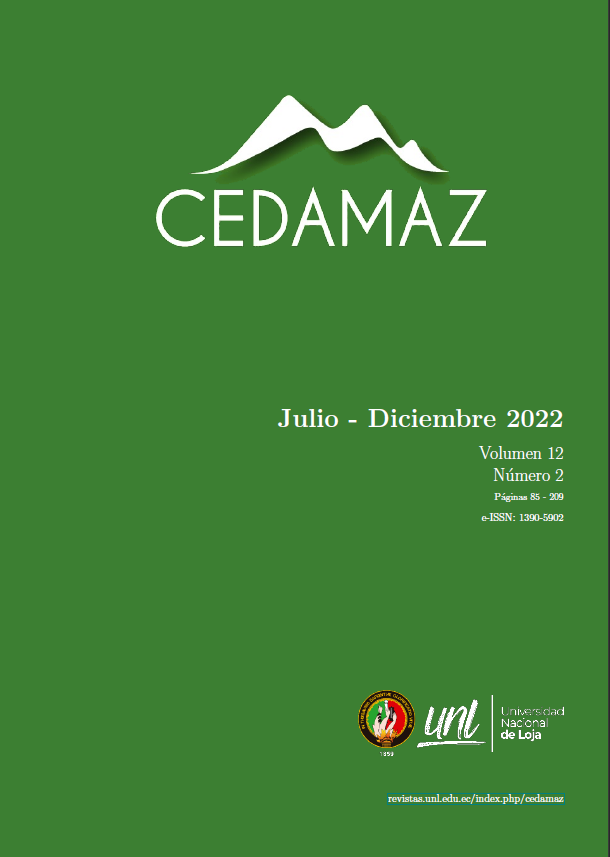Correlation evaluation between UCS and Is50 based on specimen dimensions
DOI:
https://doi.org/10.54753/cedamaz.v12i2.1712Keywords:
Compression, Stability, Mining, Resistance, Rock.sAbstract
In the development of mining activities, both open pit and underground, it is important to determine certain properties of the rocks present in the outcrops found, one of them is the unconfined compressive strength (UCS), since through this and other in situ, the stability of structures can be assessed. The UCS is evaluated by permanently sending samples to the laboratory, which is often tedious, complicated and expensive, so an alternative in the field is the assessment of the Point Load Test Index or Is 50, which is obtained from a more accessible way. The relationship that exists between the UCS and the Is 50 is proposed by several authors, but many times these theoretical correlations do not reflect reality, because there are variables that involve considerable variations and consequently distort the evaluation of the UCS. It is proposed to establish certain guidelines to find a correlation that maintains a concordance between the UCS and the Is 50, with those exposed in the theory and in this way have a greater reliability of the calculations and results. One of the guidelines is to establish the geometry of the test specimens, specifically their dimensions. Three groups of andesite specimens have been proposed, with approximate dimensions of 5x10x10 cm, 5x5x10 cm and 5x5x5 cm and the results obtained are encouraging, we can also conclude hat the proposed methodology should be introduced for field processes in mining projects.References
Blyth, F., Freitas, M. (2003). Geología para Ingenieros. México D.F., México.
Burbano, D., & García, T. (2016). Estimación empírica de la resistencia a compresión simple a partir del ensayo de carga puntual en rocas anisótropas (esquistos y pizarras). FIGEMPA: Investigación y Desarrollo, 1(2), 13–16. https://doi.org/10.29166/revfig.v1i2.862 DOI: https://doi.org/10.29166/revfig.v1i2.862
Cordero, P. (2019). Manual de prácticas de laboratorio de Mecánica de Rocas (Parte I). Universidad Nacional Autónoma de México, México D.F.
Feijoo, P., Brito, E. (2021). Rock Characterization Through Physical Properties and Their Relationship to Simple Compressive Strength. ESPOCH Congresses: The Ecuadorian Journal of S.T.E.A.M., 1(2), 931–941. https://doi.org/10.18502/espoch.v1i2.9507 DOI: https://doi.org/10.18502/espoch.v1i2.9507
Feijoo, E., Choco, E., Peláez, G. Feijoo, B. (2022). Índice de Carga Puntual y su Relación con Dimensiones en Bloque Regular de Roca. Revista Tecnológica - Espol, 34(2), 28-39. DOI: https://doi.org/10.37815/rte.v34n2.886
Feijoo, P. & Flores, C. & Feijoo, B. (2019). The Concept of the Granulometric Area and Its Relation with the Resistance to the Simple Compression of Rocks. IESTEC, p. 52–56.
Feijoo, P. Iñiguez, C. (2020). Corte en rocas y su relación con la resistencia a compresión simple. Revista Ibérica de Sistemas e Tecnologias de Informação, E30, 59-67.
Feijoo, P., Peralta, A., Tamayo, A., Feijoo, B. (2022). Tamaño de partícula del material rocoso y su correlación con el índice de prueba de carga puntual. Minerva, 3(7), 78-88. DOI: https://doi.org/10.47460/minerva.v3i7.54
Feijoo, P. & Ureña, C. (2021). Caracterización de la resistencia a la compresión en rocas mediante clasificación granulométrica: un ensayo de campo. Ingeniería y Competitividad, 24(1), 2-11. DOI: https://doi.org/10.25100/iyc.v24i1.10832
Galván, M. (2015). Mecánica de Rocas: Correlación entre la Resistencia a Carga Puntual y la Resistencia a Compresión Simple. Cali, Colombia: Universidad del Valle.
González de Vallejo, L., Ferrer, M. (2007). Manual de campo para la descripción y caracterización de macizos rocosos en afloramientos. Instituto Geológico y Minero de España. Madrid. España.
Navarrete, M., Martínez, W., Alonso, E., Lara, C., Bedolla, A., Chávez, H., Delgado, D., Arteaga, J. (2013). Ca racterización de propiedades físico-mecánicas de rocas ígneas utilizadas en obras de infraestructura. ALCONPANT, 3(2), 133-143. DOI: https://doi.org/10.21041/ra.v3i2.49
Pohjanperae, P., Wanne, T., & Johansson, E. (2005). Point load test results from Olkiluoto area borehole cores (POSIVA-WR–06-59). Finland Ramírez, P., Alejano, L. (2004). Mecánica de rocas: fundamentos e ingeniería de taludes. Universidad Politécnica de Madrid. Madrid. España.
Ramírez, P., de la Cuadra, L., Lain, R., Grigalbo. E. (1984). Mecánica de rocas aplicada a la minería metálica subterránea. Instituto Geológico Minero. Madrid. España.
Secretaria de Comunicaciones y Transporte. (2016). Manual de Diseño y Construcción de Túneles de Carreteras. México D. F., México: Secretaria de Comunicaciones y Transporte.
Published
How to Cite
Issue
Section
License
Copyright (c) 2022 CEDAMAZ

This work is licensed under a Creative Commons Attribution-NonCommercial-NoDerivatives 4.0 International License.
Those authors who have publications with this journal, accept the following terms:
- After the scientific article is accepted for publication, the author agrees to transfer the rights of the first publication to the CEDAMAZ Journal, but the authors retain the copyright. The total or partial reproduction of the published texts is allowed as long as it is not for profit. When the total or partial reproduction of scientific articles accepted and published in the CEDAMAZ Journal is carried out, the complete source and the electronic address of the publication must be cited.
- Scientific articles accepted and published in the CEDAMAZ journal may be deposited by the authors in their entirety in any repository without commercial purposes.
- Authors should not distribute accepted scientific articles that have not yet been officially published by CEDAMAZ. Failure to comply with this rule will result in the rejection of the scientific article.
- The publication of your work will be simultaneously subject to the Attribution-NonCommercial-NoDerivatives 4.0 International (CC BY-NC-ND 4.0)









